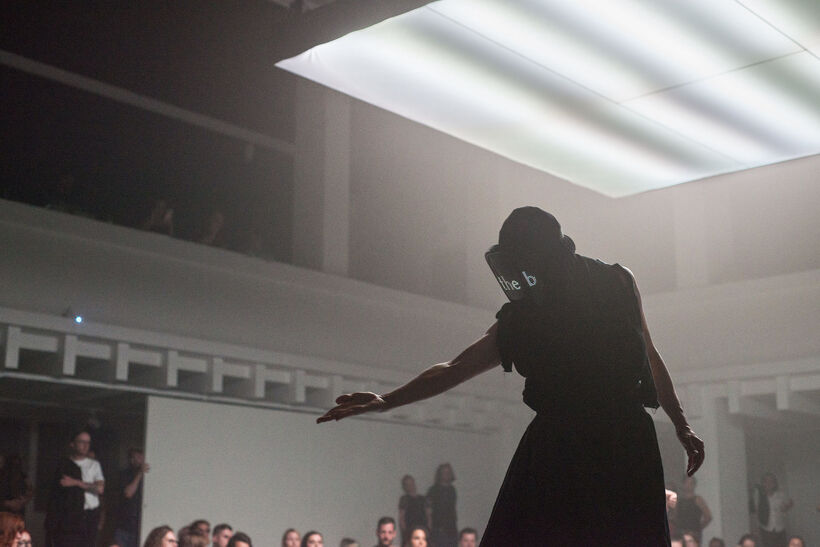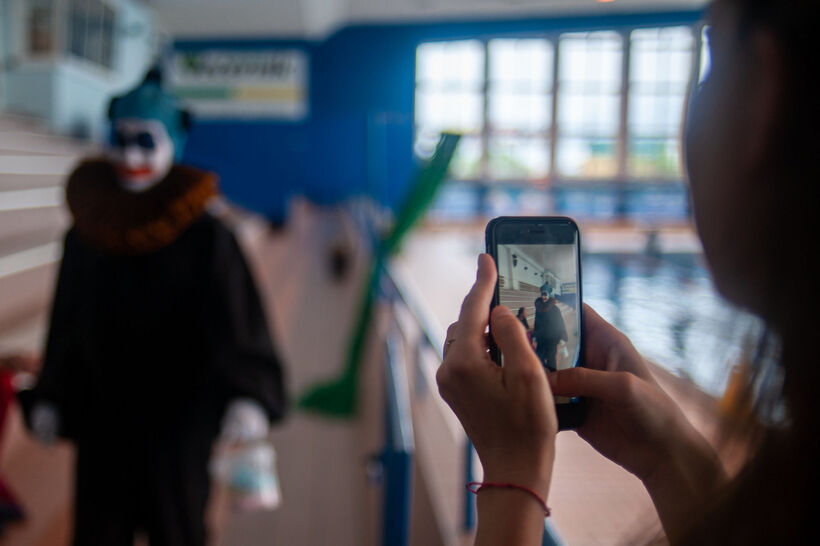Kiosk Festival – Stuck in the Mud at Humanity’s Frontier
It must have been Day 3 of Kiosk Festival for Theatre and Dance when, scrambling out of my tent – surrounded by a watery moat from the last night’s torrential rain at Stanica Cultural Centre – I understood how near to art I had come. I had forgotten tent pegs, a fly for water protection, and was using a tent called a ‘Fun Tent’ designed more for the beaches of Ibiza than the valley of a Žilina train station. Yet surrounded by other camping artists, and with the concrete goliath of Žilina’s flyover standing over us for protection – not to mention the protection of the artworks themselves – at no stage did I feel anything but safe. Such is the power of art, maybe, creating types of security and community that economic development can only dream of.
Kiosk 2022 is the 15th edition of the festival, this year returning to full strength after a smaller, pandemic-friendly version in 2021. The festival conducts a yearly mini-takeover of Slovakia’s third-largest city, sprawling across the recently-renovated New Synagogue, Centrum Labyrint, National Theatre and Stanica, as well as some specialised venues. Site-specific performances blend with proscenium arches, dance mixes with theatre and puppetry, and – a more recent phenomenon – the screen blends with the un-screened, mixing together like the rain in the earth around Stanica. There was also a cultural mix happening – it seemed at times that half of Czech Republic’s performing arts community descended on Žilina for Kiosk, while almost every minute of the action-packed program is filled with activities.
The opening night performance, 2017’s SARX from Prague-based Slovak choreographer Martin Talaga, offered a classically-based take on the festival’s theme “After Human”. The dramaturgy of Tomáš Procházka takes us firmly into the limits of the human body in its physical form, in collision (still?) with its aspirations to an ideal, god-like and civilised state. The choreography works against this cultivated version of humanity, with the dancers mimicking animalistic gestures and adopting an asynchronous constellation, finally drawing mirrors from the small architectural set by Dušan Prekop and Matej Kos, in order to bounce light around the auditorium of the New Synagogue. It’s a work that runs the gamut of European cultural and philosophical references, and is both defined and limited by this frame, with a long timeline of human development perhaps returning, in the end, to its origins.
 Day 2 began with the physical theatre of Lukáš Karásek, who’s enchanting Living Room is a masterpiece of technique, crossing physical theatre with puppetry within the confines of a child—like, fantastic room where objects burst into life, as a drawer-headed avatar (played by Karásek) renders time and space flexible. I was lucky to catch Pro(s)thetic Dialogues from Prague-based Alexandra Morales and Georgy Bagdasarov, a video work that uses fakery to target the false promises of AI, and exposes the crisis of environment as one of the human being’s own making, thankfully debunking techno-centric positions in the process. A work that divided audiences was NIC-MOC, from Brno-based prankster collective d'epog, where the stage of the National Theatre was left empty for about 90 minutes – cue dystopia in the Žilina’s audience, who’s cries of protests, spontaneous applause, and eventual stage takeover I will never forget. The day finished with Soft Spot, an offering from Hungarian choreographer Adrienn Hód in collaboration with Slovak dancers Martina Hajdyla and Sona Ferienčíková. For me, Soft Spot seemed to hit a hard spot – its production of what looked like yoga poses to a gentle harmonic hum to me offered nothing new to the on-going and important conversations on technology, the body, and dance, with its reverence towards performance a huge contrast from the playful attitude of earlier in the day. My concerns seemed un-mirrored, however, by the appreciative audience – who marked the end of Day 2 with thunderous applause – even as the actual thunder rolled in outside the protective sphere of the New Synagogue.
Day 2 began with the physical theatre of Lukáš Karásek, who’s enchanting Living Room is a masterpiece of technique, crossing physical theatre with puppetry within the confines of a child—like, fantastic room where objects burst into life, as a drawer-headed avatar (played by Karásek) renders time and space flexible. I was lucky to catch Pro(s)thetic Dialogues from Prague-based Alexandra Morales and Georgy Bagdasarov, a video work that uses fakery to target the false promises of AI, and exposes the crisis of environment as one of the human being’s own making, thankfully debunking techno-centric positions in the process. A work that divided audiences was NIC-MOC, from Brno-based prankster collective d'epog, where the stage of the National Theatre was left empty for about 90 minutes – cue dystopia in the Žilina’s audience, who’s cries of protests, spontaneous applause, and eventual stage takeover I will never forget. The day finished with Soft Spot, an offering from Hungarian choreographer Adrienn Hód in collaboration with Slovak dancers Martina Hajdyla and Sona Ferienčíková. For me, Soft Spot seemed to hit a hard spot – its production of what looked like yoga poses to a gentle harmonic hum to me offered nothing new to the on-going and important conversations on technology, the body, and dance, with its reverence towards performance a huge contrast from the playful attitude of earlier in the day. My concerns seemed un-mirrored, however, by the appreciative audience – who marked the end of Day 2 with thunderous applause – even as the actual thunder rolled in outside the protective sphere of the New Synagogue.
Day 3 began in the aforementioned puddle, and – for this critic at least – only became more difficult from there. Works such as C R ASH from Bratislava-based choreographer Martin Hodoň always leave me mystified on their insistence on creating an intense emotionality and attempting transference through performance. Perhaps it’s a sign of the times – where our anxieties, lacking an outlet, overload the stage with sublime beauty, a kind of shining, fragile light among the perceived darkness of human existence. There’s a conversation to be had about this – whether it is an approach that can produce change, or whether such works sit as a kind of re-stating of ancient platitudes, and therefore, whether they are worth making at all, regardless of the quality in technique or stagecraft on display. Surely it was more directly pleasurable than the experiment that followed, theatre score for human and machine, a sort of techno-democracy experiment from Prague-based director Peter Gonda. Acting as both a worthy addition to the theme and a very frustrating audience experiment, theatre score for human and machine puts a cast of eight non-actors into a series of exhaustive experiments with technology, including voice-recognition, AI art-generation, and audience interaction formats, as an automated grand piano sits in the corner tickling the ivories. Lasting two hours, theatre score for human and machine is the kind of painful experiment where an audience sits in mild amusement as the machines do their thing – is it a journey we are invited to join? Or is it more for the machines to strut their stuff? Yet from the frustration, the work produces moments of aporia that suggest that art can happen without our direct intervention – very much on-theme, then.
Day 3 concluded with a collective dinner by Dávid Koronczi, talk from Bratislava-based scientist and artist András Cséfalvay on the declassification of Pluto as a planet, and another great DJ set at Stanica. This seemed to lead nicely into the final Day 4, where a slightly broken critic stumbled over to Žilina’s Indoor Swimming Pool (Mestská krytá plaváreň) for the two final works of the program: Tereza Sikorová and Tomáš Moravanský (from Institute Institute)’s Dead in the Pool. The adventure of swimming in what was Czechoslovakia’s first Olympic-standard swimming pool under the shadow of Sikorová and Moravanský’s clown creation is equalled in the installation Exergonic Odyssey, which acts as a kind of tour in the underbelly of the pool itself, with a series of installation-interventions guiding the way.
As usual with such events today, there was a post-pandemic, hollowed-out feeling among the crowds as we lurched from performance to performance, as though something was missing – seemingly reinforcing the inhumanity of the theme. The works of this year’s Kiosk proposed some intriguing questions for dramaturgs and co-directors Michaela Pašteková and Martin Krištof for next year’s edition – what comes after ‘after’, for the Human? In the meantime, Kiosk 2022 offered a program that was very much in the zeitgeist of performing arts today – struggling for a unified theme other than collapse, increasingly in retreat against the encroachment of capitalism, militarisation, and hate cultures of the internet, and yet somehow offering a meaningful resistance to them anyway.
Written from Festival for Theatre and Dance Kiosk, 28th to 31st of July, 2022, in Žilina, Slovakia.
The author’s detailed, day-by-day critical account of Kiosk 2022 is available at www.theaterstuck.blogspot.de





